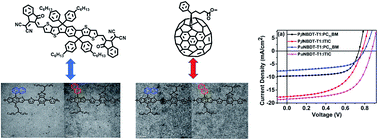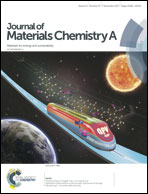Efficient fullerene-free solar cells with wide optical band gap polymers based on fluorinated benzotriazole and asymmetric benzodithiophene†
Abstract
In this work, α- and β-position naphthalene substituents as side chains on asymmetric BDT were used as donor building blocks to build wide bandgap (WBG) donor materials (PαNBDT-T1 and PβNBDT-T1) with fluorinated benzotriazole (T1) as the acceptor unit. The two co-polymers were used to build polymer solar cells (PSCs) with PC71BM or ITIC acceptor material. In ITIC acceptor material based devices, the PαNBDT-T1 co-polymer with a larger dihedral angle between main backbone and naphthalene ring achieved a higher power conversion efficiency (PCE) of 9.60% with improved short-circuit current density (JSC) and fill factor (FF) compared with PβNBDT-T1, which was ascribed to the excellent morphology of the blended film. The open circuit voltage (VOC) was also maintained at a decent level upon introducing these naphthalene rings due to their high ionization potential and low electron density. Interestingly, for PC71BM based devices, the two polymers show a reverse situation compared with an ITIC system. The PβNBDT-T1 with a small dihedral angle between the main backbone and naphthalene rings shows a slightly higher performance than PαNBDT-T1. However, in the PC71BM system, both polymers did not exhibit ideal optical performance due to their unmatched absorption spectrum. These phenomena indicate that the asymmetric BDTs have great potential towards achieving high optical performance with non-fullerene acceptor materials.



 Please wait while we load your content...
Please wait while we load your content...